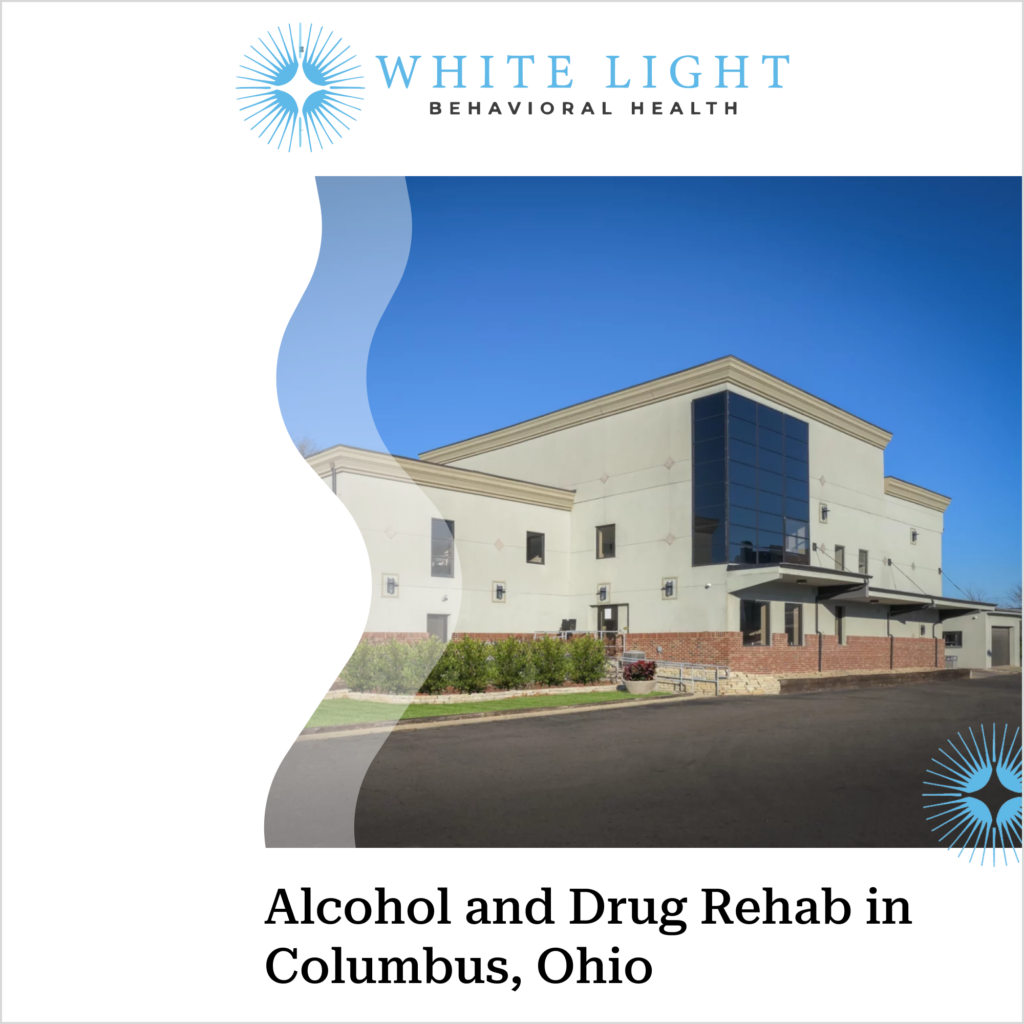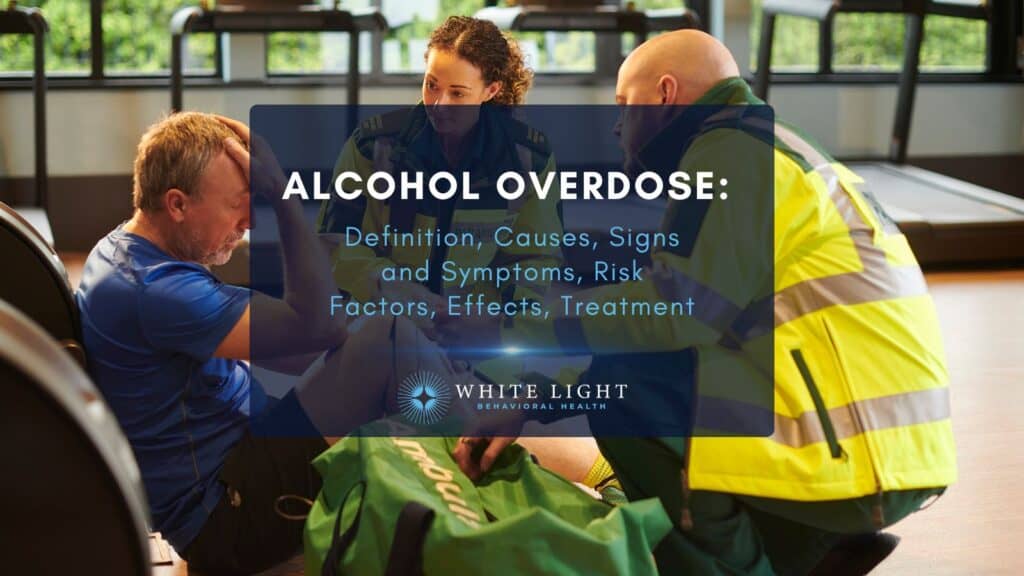Clonazepam/Klonopin Addiction: Signs, Causes, Effects, and Treatment
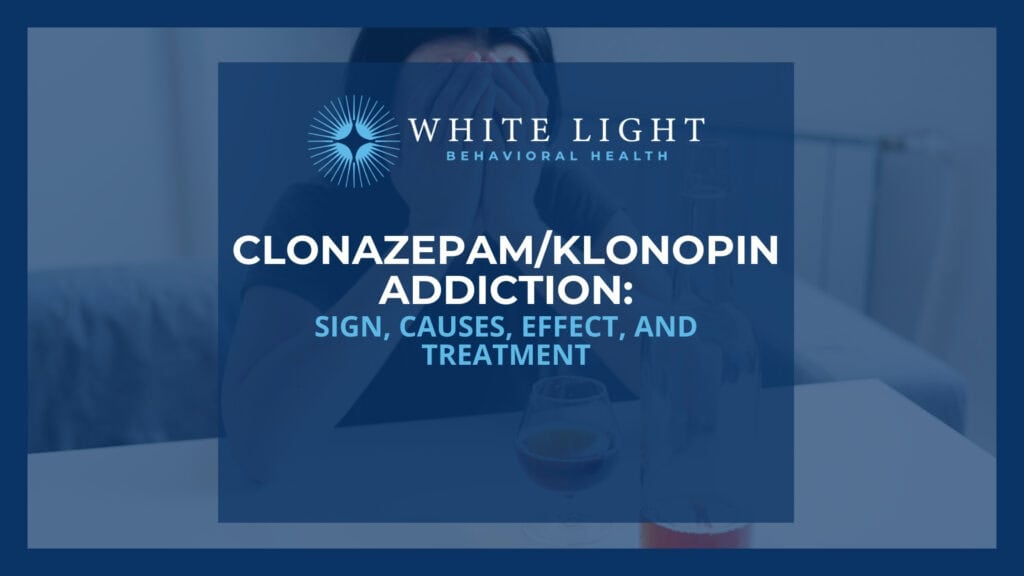
Clonazepam/Klonopin addiction involves prolonged, compulsive use of this benzodiazepine that alters your brain function, making the drug essential for normal functioning. It poses a high addiction risk, especially with long-term or unsupervised use.
Ohio law classifies Clonazepam as a Schedule IV controlled substance, regulating its prescription and dispensing to reduce misuse and addiction risk. In Ohio alone, over 132 million solid doses of benzodiazepines were dispensed in just six months (July-December 2016), equivalent to 23 pills for every person in the state.
Clonazepam addiction symptoms include inability to stop use, concentration problems, fainting, numbness, and confusion. Long-term use of Clonazepam risks serious health issues and overdose.
Causes of Clonazepam addiction include genetics, mental health disorders, and prior substance abuse. The effects of Clonazepam range from mild to severe, with risks of depression, aggression, and overdose.
Effective recovery from Clonazepam addiction requires a comprehensive treatment plan with monitored medication and various therapies.
What is Clonazepam (Klonopin) Addiction?
Clonazepam (Klonopin) addiction is a substance use disorder characterized by the compulsive use of clonazepam, a benzodiazepine medication, despite harmful consequences and an inability to control or stop its use. This addiction develops when individuals become physically and psychologically dependent on the drug, requiring increasingly larger doses to achieve the same effects (tolerance) and experiencing withdrawal symptoms when attempting to reduce or discontinue use.
Clonazepam addiction involves continued use beyond prescribed medical guidelines, drug-seeking behaviors, neglect of responsibilities, and persistent cravings for the medication, ultimately leading to significant impairment in personal, social, occupational, or other important areas of functioning.
Did you know most health insurance plans cover substance use disorder treatment? Check your coverage online now.
Is Clonazepam Addictive?
Yes, Clonazepam is addictive. It is effective and safe for short-term use in treating anxiety but misuse leads to addiction. Addiction often involves combining Klonopin with other drugs or alcohol.
According to the Substance Abuse and Mental Health Services Administration (SAMHSA), approximately 95% of individuals seeking treatment for benzodiazepine addiction are also abusing another substance. This polysubstance use dramatically increases the risk of overdose and death.
More Resources on Addiction:
What is Clonazepam (Klonopin)?
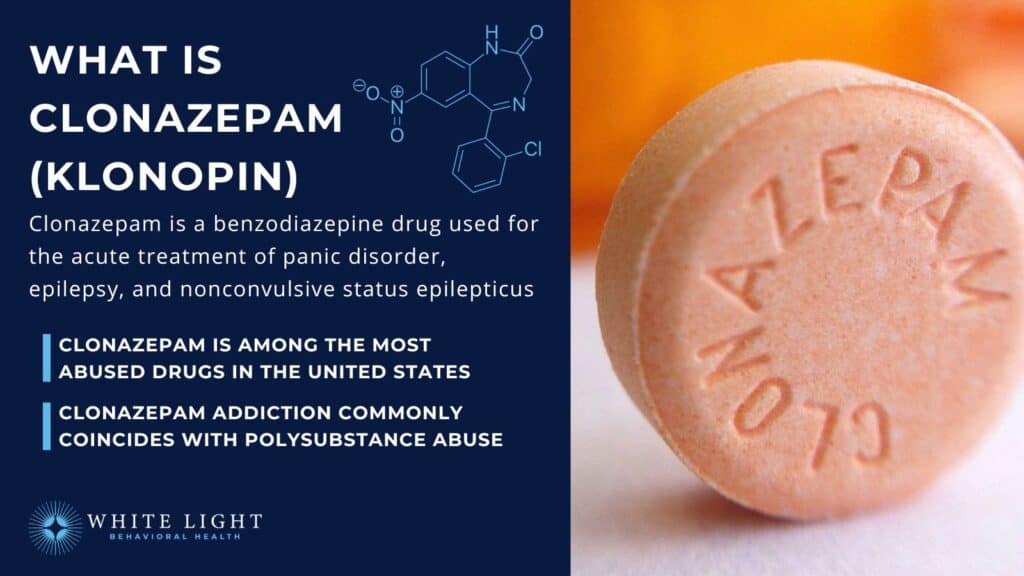
Clonazepam, known by its brand name Klonopin, is a benzodiazepine, a class of drugs that, while effective for treating various anxiety and seizure disorders, ranks among the most abused prescription medications in the United States. It is prescribed less frequently than Xanax (alprazolam) and Ativan, but like these medications, Clonazepam shares similar properties with differences in its speed of action and duration of effects.
Clonazepam is specifically indicated for the treatment of conditions such as panic disorder, social anxiety disorder, and generalized anxiety disorder. It is also used in the management of spasticity and seizure disorders, among other medical conditions.
What Are The Signs or Symptoms of Clonazepam (Klonopin) Addiction?
The signs or symptoms of Clonazepam (Klonopin) addiction are observable through behavioral changes, such as exceeding prescribed dosages and neglecting responsibilities, alongside physical manifestations like a racing heart rate and nausea, and psychological effects including persistent drug cravings and hallucinations.
Here are the signs or symptoms of Clonazepam (Klonopin) addiction in detail below:
Behavioral Signs
- Exceeding prescribed dosage: Individuals take larger amounts of Klonopin or use the medication for longer periods than their doctor prescribed.
- Doctor shopping: Patients visit multiple physicians to obtain additional Klonopin prescriptions from different sources.
- Secretive drug use: Users hide their Klonopin consumption from family members and friends who should know about their medication use.
- Neglecting responsibilities: Performance at work, school, or home declines significantly due to drug impairment and preoccupation with use.
- Social withdrawal: Individuals spend less time with family and abandon previously enjoyed activities in favor of drug use.
- Inability to stop usage: People experience repeated failures when attempting to quit or reduce Klonopin consumption despite a genuine desire to stop.
Physical Signs
- Racing heart rate: Patients develop tachycardia and heart palpitations as physical responses to Klonopin addiction.
- Numbness in extremities: Users experience persistent tingling sensations in their arms and legs during regular use.
- Nausea and vomiting: Gastrointestinal disturbances occur frequently as the body reacts to ongoing Klonopin abuse.
- Sensitivity to light and sound: Individuals develop heightened sensory reactions that make normal environmental stimuli uncomfortable.
- Blurred vision: Visual disturbances accompany coordination problems that affect daily functioning and safety.
- Muscle weakness: Physical strength diminishes significantly along with the development of unsteady walking patterns.
Contact us today to schedule an initial assessment or to learn more about our services. Whether you are seeking intensive outpatient care or simply need guidance on your mental health journey, we are here to help.
Psychological Signs
- Preoccupation with using Klonopin: Thoughts center obsessively on obtaining and using the drug despite serious negative consequences.
- Persistent drug cravings: Strong urges and compulsive drug-seeking behavior develop as addiction takes hold of brain chemistry.
- Memory problems: Short-term memory loss and mental confusion occur regularly as cognitive function deteriorates.
- Personality changes: Mood swings and behavioral alterations become apparent to family members and close friends.
- Auditory hallucinations: Users experience hearing sounds that are not actually present in their environment.
- Suicidal thoughts: The FDA warns specifically about increased suicidal ideation risk associated with Klonopin use.
What Are The Predisposing Factors or Causes of Clonazepam Addiction?
The causes of clonazepam addiction include heredity, environment, history of substance abuse, and mental health disorders.
Here are the key risk factors of clonazepam addiction:
- Heredity: individuals with a family history of drug abuse or misuse are more likely to develop an addiction. It isn’t inevitable, but the risk of it happening is higher than for people without such a history.
- Previous substance use abuse: individuals who have a history of substance use disorder are more susceptible to clonazepam addiction, according to the Drug Enforcement Administration (DEA)
- Environment: individuals living in areas where Clonazepam is easily accessible, perhaps because someone around uses it, are at a higher risk of developing clonazepam addiction.
- Mental Health Disorders: people battling mental health disorders are very susceptible to abusing or misusing drugs because they tend to self-medicate for relief of symptoms. Therefore, they are at a higher risk of clonazepam addiction.
What Are The Effects of Clonazepam (Klonopin) Addiction?
Clonazepam addiction side effects include:
- Dizziness: Clonazepam slows brain signals that control balance, causing lightheadedness and dizziness.
- Numbness: Clonazepam alters nerve function, reducing sensation in limbs and other body parts.
- Fainting: Clonazepam lowers blood pressure and depresses the central nervous system, leading to sudden loss of consciousness.
- Vertigo: Clonazepam disrupts the inner ear and brain balance centers, resulting in spinning sensations.
- Confusion: Clonazepam interferes with brain chemicals needed for clear thinking, leading to mental confusion.
- Impaired cognition: Clonazepam reduces memory, learning, and processing abilities by affecting brain activity.
- Reduced libido: Clonazepam impacts hormone and neurotransmitter balance, decreasing sexual desire.
- Impaired judgment: Clonazepam slows decision-making and risk assessment functions in the brain.
- Depression: Clonazepam alters mood-regulating neurotransmitters, causing persistent sadness and low mood.
- Poor concentration: Clonazepam suppresses brain alertness, diminishing the ability to focus.
- Aggression: Clonazepam affects brain regions that regulate emotions, sometimes increasing irritability and hostility.
- Insomnia: Clonazepam withdrawal disrupts normal sleep patterns, resulting in difficulty falling or staying asleep.
- Seizures: Sudden cessation of Clonazepam causes brain hyperactivity, triggering convulsions or seizures.
- Overdose: Excess Clonazepam depresses vital brain and respiratory functions, risking fatal outcomes.
What Are the Side Effects of Clonazepam?
Clonazepam causes side effects, including drowsiness, dizziness, muscle weakness, blurred vision, confusion, memory problems, mood changes, breathing difficulties, liver problems, and increased suicide risk. The NHS reports common effects include drowsiness in up to 50% of patients, poor coordination in up to 30%, and dizziness in up to 12% of users.
Is It Possible To Overdose On Clonazepam?
Yes, it is possible to overdose on Clonazepam when misused or combined with other depressants. Clonazepam leads to severe respiratory depression, coma, and even death when mixed with opioids or consumed in large amounts.
According to Jonathan Brett and Bridin Murnion in their article “Management of benzodiazepine misuse and dependence” (Aust Prescr 2015;38:152–5), the dangers of benzodiazepines like Clonazepam include morbidity and mortality related to overdose. The risk is compounded by the drug’s potential for dependence and withdrawal symptoms, underscoring the need for careful prescription management and monitoring. The authors also highlight the importance of gradual tapering rather than abrupt cessation to mitigate withdrawal risks, which include severe complications such as seizures.
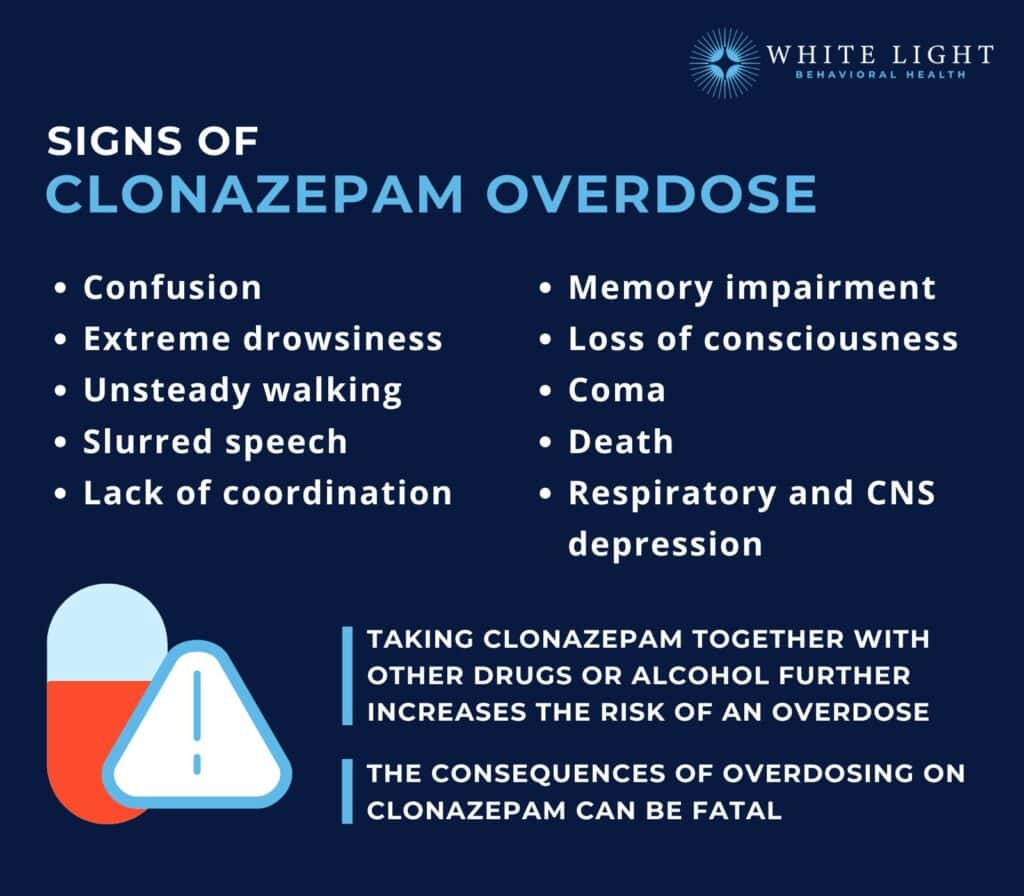
Rediscover Life at White Light Behavioral Health
Get the compassionate support you deserve. We're here to help you reclaim joy, wellness, and a brighter future.
Our Facility
What Are The Signs of Clonazepam Overdose?
The signs of Clonazepam Overdose include:
- Confusion
- Extreme drowsiness
- Unsteady walking
- Slurred speech
- Lack of coordination
- Memory impairment
- Loss of consciousness
- Respiratory and CNS depression
- Coma
- Death
What Are The Signs Of Clonazepam Withdrawal?
Withdrawal symptoms of Klonopin addiction may include:
- Hand tremor
- Sweating and rapid heart rate
- Vomiting
- Nausea
- Sleep difficulties
- Anxiety
- Hallucinations
- Seizures
Once dependence on or addiction to Clonazepam has developed, any attempt to discontinue or cut back on usage may lead to withdrawal symptoms. Withdrawal symptoms happen when the body is trying to readjust, having been altered to see clonazepam as an essential element of its normal functioning.
Withdrawal is one of the most difficult parts of a recovery journey from addiction. It can be very overwhelming and dangerous, hence it should be done under medical supervision. Experts sometimes gradually reduce Clonazepam use till it’s eventually stopped, rather than stopping it at once, to minimize the severity of withdrawal symptoms.
How is Clonazepam (Klonopin) or Benzodiazepine Addiction Treated in Ohio?
Clonazepam (Klonopin) or Benzodiazepine addiction is treated in Ohio through immediate management of withdrawal, long-term pharmacological interventions, psychological and behavioral interventions, addressing polysubstance abuse, monitoring, and continuing care, community and support systems. At White Light Behavioral Health, we provide benzodiazepine addiction treatment across Ohio.
Our experienced team specializes in safely managing withdrawal and creating personalized plans that address physical dependence and mental health. With detox, residential, and outpatient programs, we are committed to supporting you or your loved one through every step of benzodiazepine addiction recovery.
1. Immediate Management of Withdrawal
Initial treatment focuses on safely managing withdrawal symptoms, which are severe and include anxiety, insomnia, seizures, and even psychosis. According to Michael F. Weaver in “Prescription Sedative Misuse and Abuse” (Yale Journal of Biology and Medicine, 2015), a controlled tapering off the drug is often necessary, utilizing longer-acting benzodiazepines like diazepam or sometimes even using a substitution strategy with drugs like phenobarbital to mitigate the withdrawal risks.
2. Long-term Pharmacological Interventions
Once stabilization is achieved, long-term treatment plans often incorporate medications to manage ongoing withdrawal symptoms and prevent relapse. Flumazenil reverses benzodiazepine effects in overdoses but sees limited use in withdrawal due to seizure risks.
Are you covered for treatment?
White Light Behavioral Health is an approved provider for Blue Cross Blue Shield and TUFTS, while also accepting many other major insurance carriers.
Check Coverage Now!3. Psychological and Behavioral Interventions
Psychological support is critical in treating Clonazepam addiction.
Cognitive-behavioral therapy (CBT) and motivational interviewing are commonly employed to address the behavioral patterns and mental health issues underlying substance use. Weaver’s discussion emphasizes the role of these therapies in helping individuals develop healthier coping mechanisms and recovery strategies.
4. Addressing Polysubstance Abuse
Many individuals with Clonazepam addiction also abuse other substances, complicating treatment. As described in the comprehensive guidelines from “Management of benzodiazepine misuse and dependence” by Jonathan Brett and Bridin Murnion (Aust Prescr, 2015), a careful assessment of all substances used is necessary, with a treatment plan that addresses all aspects of the individual’s substance use.
5. Monitoring and Continuing Care
Continuous monitoring through urine drug tests and prescription drug monitoring programs is recommended to prevent relapse and ensure compliance with the treatment regimen, as highlighted in both Weaver’s and Brett and Murnion’s analyses. Regular follow-ups and adjustments to the treatment plan based on the patient’s progress and any new health issues are crucial components of effective management.
6. Community and Support Systems
Engagement with community resources, support groups, and addiction recovery programs provides the necessary social support and resources to aid in long-term recovery. These networks are vital for providing ongoing encouragement and for helping individuals navigate the challenges of recovery outside of a clinical setting.
By integrating these diverse therapeutic approaches, the treatment of Clonazepam addiction effectively managed, providing individuals with the tools and support necessary for recovery. Each aspect of treatment is critical, addressing both the immediate physical challenges of withdrawal and the long-term psychological and social factors contributing to substance use.
Is it Safe to Quit Klonopin Yourself?
It is not safe to quit Klonopin (clonazepam) on your own. According to the study titled “A Case Report of Clonazepam Dependence: Utilization of Therapeutic Drug Monitoring During Withdrawal Period” by Ivana Kacirova and Milan Grundmann, published in Medicine in March 2016, the abrupt cessation of Clonazepam led to severe withdrawal symptoms that required medical supervision. The study emphasizes the importance of gradual tapering and therapeutic drug monitoring to safely manage withdrawal symptoms and reduce risks associated with sudden discontinuation.
Did you know most health insurance plans cover substance use disorder treatment? Check your coverage online now.
How Long Does Klonopin Stay in the Body?
Klonopin (clonazepam) stays in the body for 18 to 50 hours, as the medication has a half-life in this range, meaning it takes this amount of time for the concentration of the drug in the blood to be reduced by half. This information is detailed in the “Medication Fact Sheet” by the American Association of Psychiatric Pharmacists, available through resources like the National Alliance on Mental Illness, and was last updated in January 2016. This duration varies depending on factors such as the individual’s metabolism, age, health status, and the duration of use.
How Does Clonazepam Treatment Differ In Patients With Concurrent Substance Abuse Issues?
In cases of concurrent substance abuse, treatment with Clonazepam requires a specialized approach to manage multiple dependencies simultaneously. As detailed in “A Case Report of Clonazepam Dependence: Utilization of Therapeutic Drug Monitoring During Withdrawal Period” by Ivana Kacirova and Milan Grundmann (Medicine, 2016), patients like the case subject, who was also using alprazolam, require integrated care plans that address the complexities of polydrug abuse, highlighting the necessity for a comprehensive treatment strategy that includes close monitoring and adaptation based on individual patient profiles.
How Does Clonazepam/ Klonopin Addiction Compare to a Methamphetamine/ Meth Addiction?
Clonazepam/ Klonopin addiction and Methamphetamine/ Meth addiction compare in terms of detrimental effects on an individual’s physical and mental well-being, but differ in their mechanism of action and potential side effects. Clonazepam/ Klonopin, a benzodiazepine, acts on the central nervous system to produce calming effects.
Methamphetamine/ Meth, a stimulant, increases activity in the brain and produces a euphoric high. Withdrawal symptoms and treatment approaches also vary between these two addictions.
How Does Clonazepam/ Klonopin Addiction Compare To A Fentanyl Addiction?
Clonazepam/ Klonopin addiction compares to a Fentanyl addiction by having different effects and treatments, although both are serious substance use disorders. Fentanyl is a stronger and more potent drug; therefore, it leads to a higher risk of overdose and death.
Treatment for Fentanyl addiction requires medication-assisted therapy, while Clonazepam/ Klonopin addiction is treated with cognitive-behavioral therapy and gradual tapering off of the drug. Both addictions require professional medical and therapeutic help.
Share This Post







